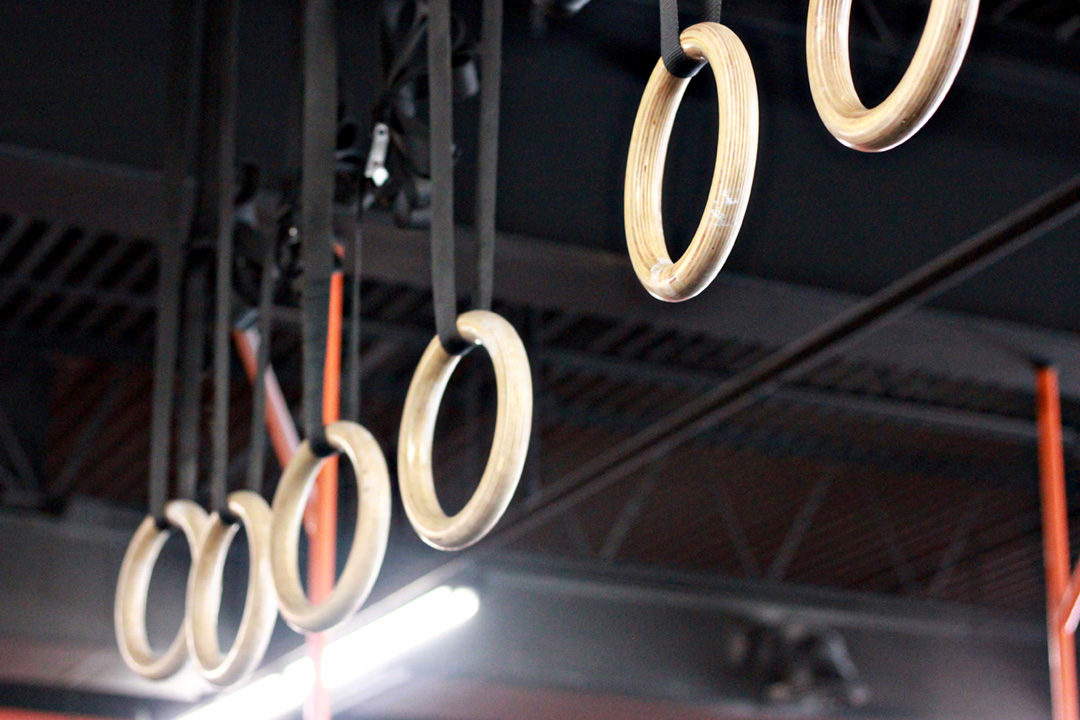 So let’s be real, CrossFit terms can get confusing. WODs, AMRAPs and EMOMs, oh my!
So let’s be real, CrossFit terms can get confusing. WODs, AMRAPs and EMOMs, oh my!When you walk into a gym for the first time, the acronym overload is real and for the first six months, you’re doing good just to get through the WOD, much less memorize the differences between a hang clean, a power snatch and a push jerk.
That’s where we come in. Whether you’re new at CrossFit or need a better resource for your new members, FitnessHQ has you covered.
Some concepts are more difficult to explain than others. Some movements need a video demonstration to truly do them justice. Some movements you’ll have to work on with your certified coach to really catch the gist. But here, you can find our simplest explanations for things, visuals and a solid start to learning the ins and outs of the CrossFit world.
Be sure to let us know if there are more words, phrases or movements that you think merit a place in our CrossFit glossary.
The First Acronym You Need to Know
WOD – Workout of the day.
Workout Types
- AMRAP – As many rounds as possible of a workout in a given amount of time, using the number of reps or times completing the WOD as a score
- Bear Complex – a five lift complex consisting of a power clean, a front squat, a push press, a back squat and another push press.
- Chipper – A WOD that consists of a series of movements that are not repeated. In addition, the participant must complete all of the reps for the exercise before moving on to the next. One of the classic chippers in CrossFit is the “Filthy Fifty” that consists of doing 50 reps of box jumps, jumping pull ups, kettlebell swings, walking lunges, knees to elbows, push presses, back extensions, wall balls, burpees, and double unders.
- Couplet – a WOD consisting of two exercises. An example of a couplet in CrossFit is Fran, which includes thrusters and pull ups.
- EMOM – Every minute on the minute
- Fight Gone Bad
- For Time – Complete the workout as quickly as possible, using the time it takes to complete it as your score
- Metcon – Short for metabolic conditioning, a metcon usually features a set of movements repeated for a certain time period, like what you would see in an AMRAP. Metcons are usually short, intense, and require constant movement and muscle use.
- Tabata – High-intensity interval training system that requires four minutes per exercise. For each exercise, you will do 20 seconds of work followed by ten seconds of rest, resulting in 8 rounds in 4 minutes. The BIG key to Tabata workouts, at least as they relate to CrossFit is that only the lowest score is counted, so you don’t want to go all out in the first round only to end up fizzling out later.
- Triplet – a WOD consisting of three exercises. An example of a triplet in CrossFit is Helen, which includes running, kettlebell swings and pull ups.
Olympic Lifts/Weight Movements
- Back Squat – Completing a full squat with the barbell resting on the back of your shoulders. For a video demonstration of a back squat, click here.
- Clean and Jerk – Combine a power clean or squat clean and push jerk or split jerk. For a video demonstration of a clean and jerk, click here.
- Curtis P’s – See also, the devil. No just kidding…sort of. Curtis P’s are a squat clean followed by two forward lunges with the barbell in the front rack position and then a push press.
- Deadlift – For a video demonstration of a deadlift, click here.
- Front Squat – Completing a full squat with the barbell in the front rack position. For a video demonstration of a front squat, click here.
- Hang Position – Starting a lift from the knees.
- High Hang Position – Starting a lift from the hip pocket.
- Muscle Snatch – The bar will start on the ground and you will grip it with a wide grip, also known as a snatch grip, while positioning your feet shoulder width apart. You will move the bar from the ground to overhead without bending your knees. You should use a hook grip for this lift. For a video demonstration of a muscle snatch, click here.
- Overhead Squat – Completing a full squat with the barbell in the overhead position. Here’s a video demonstration of an overhead squat.
- Power Clean -The bar will start on the ground and you will grip it with a little bigger than a hip-width grip while positioning your feet shoulder-width apart. Your shoulders should extend slightly over the bar while your back remains flat and your chest stays up. You will perform a slow pull to mid-thigh, where you will then “explode” and throw your hips forward, flipping your elbows quickly under the bar and receiving it in the front rack position with your knees slightly bent. You should use a hook grip for this lift. For a video demonstration of a power clean, click here.
-
Power Snatch – The bar will start on the ground and you will grip it with a wide grip, also known as a snatch grip, while positioning your feet shoulder width apart. You will perform a slow pull to mid-thigh, where you will then “explode” and throw your hips forward, dropping quickly underneath the bar and then pressing it out overhead. You should use a hook grip for this lift. For a video demonstration of a power snatch, click here. For tips on how to improve your power snatch, click here.
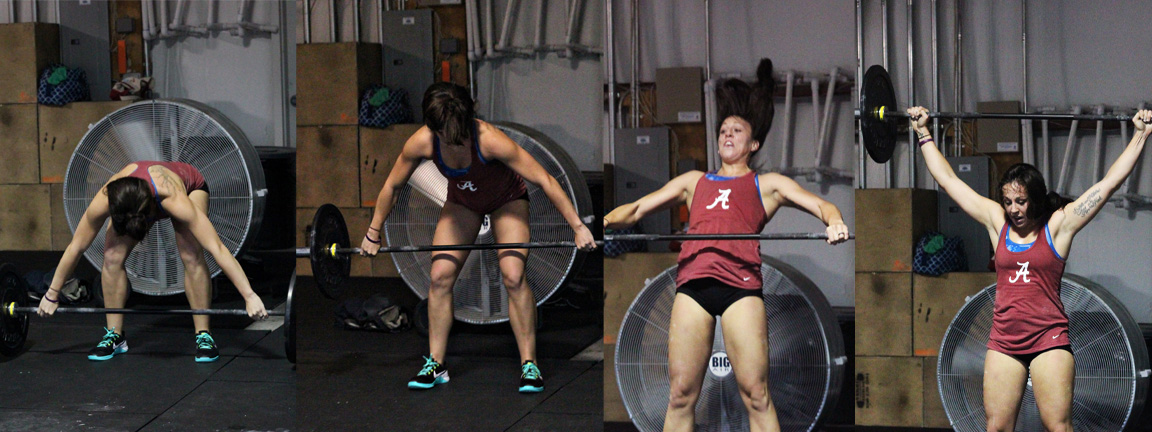
- Push Jerk – From the front rack position, you will push the bar into the overhead position by bending your knees and dropping under the bar, receiving it in a partially overhead position. Your feet should be shoulder-width apart and your grip on the bar should be a little wider than your shoulders. For a video demonstration of a push jerk, click here.
- Push Press – Moving the bar from the front rack position to overhead by bending your knees and then locking them out while driving up.Use a hook grip for this movement. For a video demonstration of a push press, click here.
- Shoulder Press – Moving the bar from the front rack position to overhead without bending your knees or using your legs. For a video demonstration of a shoulder press, click here. Sometimes also referred to as a strict press.
- Snatch -The bar will start on the ground and you will grip it with a wide grip while positioning your feet shoulder width apart. You will perform a slow pull to mid-thigh, where you will then “explode” and throw your hips forward, dropping quickly underneath the bar into a squat and catching the bar in the overhead position before driving up and completing the lift. You should use a hook grip for this lift. For a video demonstration of a snatch, click here. For tips on how to improve your snatch, click here.
- Snatch Balance – Start in the standing position with the bar positioned across your back like you would have it for a back squat. Your feet should be shoulder-width apart and you should have a snatch grip on the bar. Drop underneath the bar in a full squat while pushing the bar up. Once you hit the bottom of the squat, pause for a second and then return to the standing position while keeping the bar overhead. For a video demonstration of a snatch balance, click here.
- Snatch Press – Start in the standing position with the bar positioned across your back like you would have it for a back squat. Your feet should be shoulder-width apart and you should have a snatch grip on the bar. Then, without using your legs and keeping your core engaged, push the bar into the overhead position. Use a hook grip for this movement. For a video demonstration of a snatch press, click here.
- Split Jerk -From the front rack position, you will push the bar into the overhead position by bending your knees and dropping under the bar, receiving it in a partially overhead position with one foot in front of you and the other foot behind you. Be sure to talk with your coach about the proper way to exit this lift to prevent injury. For a video demonstration of a split jerk, click here.
-
Squat Clean – Receiving your clean in the squat position. For a video demonstration of a squat clean, click here.
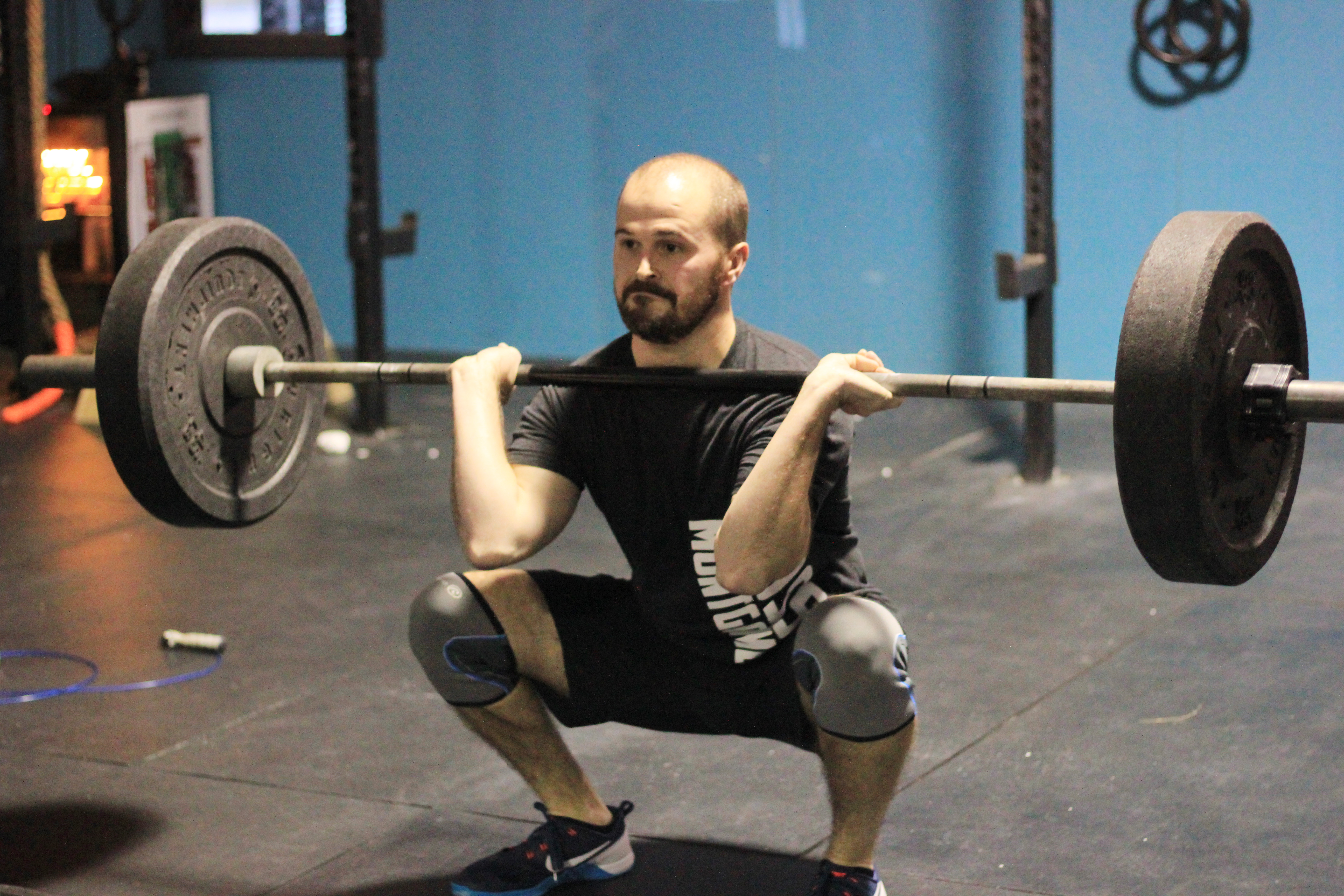
- Squat Snatch Press – Start in the squat position with the bar positioned across your back like you would have it for a back squat. You should have a snatch grip on the bar. Then, without using your legs and keeping your core engaged, push the bar into the overhead position. Use a hook grip for this movement. For a video demonstration of a squat snatch press, click here.
- Strict Press – Moving the bar from the front rack position to overhead without bending your knees or using your legs. For a video demonstration of a strict press, click here. Sometimes also referred to as a shoulder press.
- Sumo Deadlift High Pull – Keeping a narrow grip on the bar and your feet more than shoulder width apart, lift the bar to the middle of your chest. Your hips and shoulders should rise simultaneously and you should initiate the movement with a shrug, followed by a pull. The lift is complete when you’re at full extension. For a video demonstration of a sumo deadlift high pull, click here.
- Thruster – Starting with your barbell in the front rack position, you will do a full squat and then come to full extension while pushing the bar overhead. Your feet will be shoulder-width apart and your grip should be slightly outside of your shoulders. Your elbows should not touch your knees during this movement. For a video demonstration of a thruster, click here.
Other CrossFit Movements
- Abmat Sit Up – A sit up using an Abmat with your feet pressing together in the front. Your hands should touch the floor behind your head when you begin the movement and end by touching your feet. For a video demonstration of an Abmat sit up, click here.
- Air Squat – squatting below parallel while driving your knees out over your toes and keeping your chest up. For a video demonstration of an air squat, click here.
- American Kettle Bell Swing – A kettle bell is actually a piece of equipment, but when CrossFitters refer to kettle bells in a WOD, they are referring to a movement where you begin with your feet hip-width apart. You grasp the kettle bell by its handle with both hands and hang it between your legs. Then, you thrust your hips forward and use the momentum to swing the kettle bell over your head. For a video demonstration of a kettle bell, click here. Sometimes also referred to as just a Kettle Bell Swing.
- Back extension – Done using a GHD machine and not be confused with a hip extension. For a video demonstration of how to do a proper back extension, click here.
- Box Jumps – For a box jump over, you will start on the ground with your feet shoulder width apart. Boxes come in various sizes, the most common being 12 inches, 20 inches, 24 inches and 30 inches. To complete a box jump, you will start on one side of the box and jump on top of it, landing with both feet and standing all the way up with your hips fully extended. For a video demonstration for how to do a box jump, click here.
-
Box Jump Overs – For a box jump over, you will start on the ground with your feet shoulder width apart.Boxes come in various sizes, the most common being 12 inches, 20 inches, 24 inches and 30 inches. You will jump on the top of the box, making sure both feet touch before stepping or hopping down to the other side. In a box jump over, a full hip extension is not required.
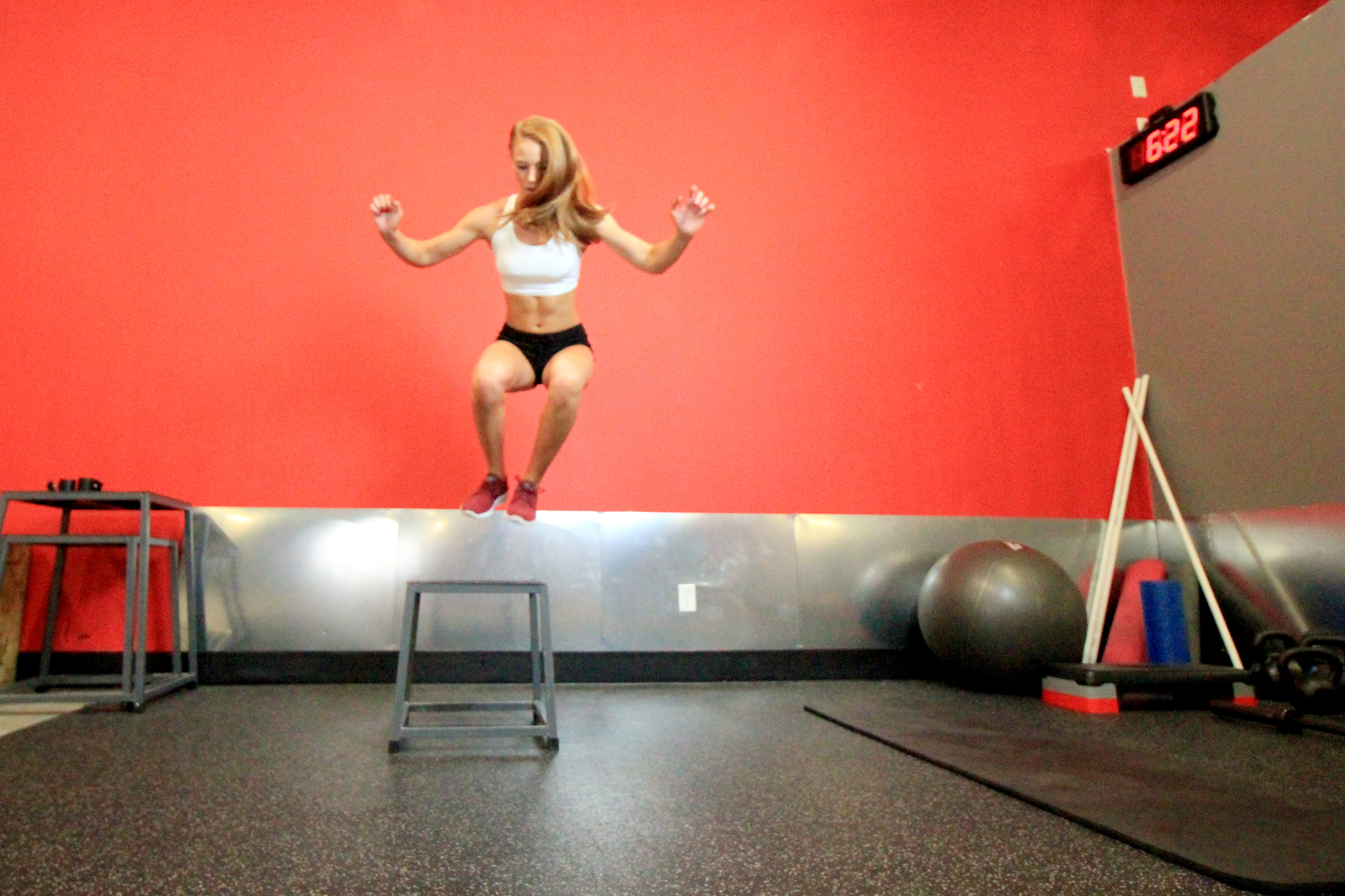
- Burpees – You will start in a standing position with your feet shoulder-width apart. You will place your hands on the ground in front of you shoulder width apart, pulling your body down to a pull up position. Your chest and thighs must touch the floor and your feet cannot come off the ground unless you are modifying the burpee. You will then jump and bring your feet to your hands before jumping. Although you will end up in a full standing position, a burpee is not considered valid if you do not jump as you come up off the floor and clap your hands above your head. For a video demonstration of a burpee, click here.
- Burpee Box Jumps – Do a burpee and then jump onto the box and over to the other side for one rep. Full extension is not required at the top of the box unless otherwise specified in the WOD or by your coach.
- Butterfly Pull Up – A type of kipping pull up. For a video demonstration of a butterfly pull up, click here.
- Chest to Bar Pull Up – Like the name suggests, this is a pull up where your chest much touch the bar for the rep to count.
- Chin Up – using a pull up bar, you will wrap your hands around the bar shoulder-width apart with your knuckles facing towards you and pull yourself over the bar.
- Double Unders – For a video demonstration of double unders, click here.
- Farmer’s Carry – Carrying a heavy weight — usually kettle bells — by your side in one hand (or one in each hand) for a predetermined amount of distance.
-
Forward Sled Push – For a video demonstration of a forward sled push, click here. Sometimes also referred to as a prowler.
-
Front Rack Weighted Lunges – Lunging while holding a barbell, with or without weight, in the front rack position.
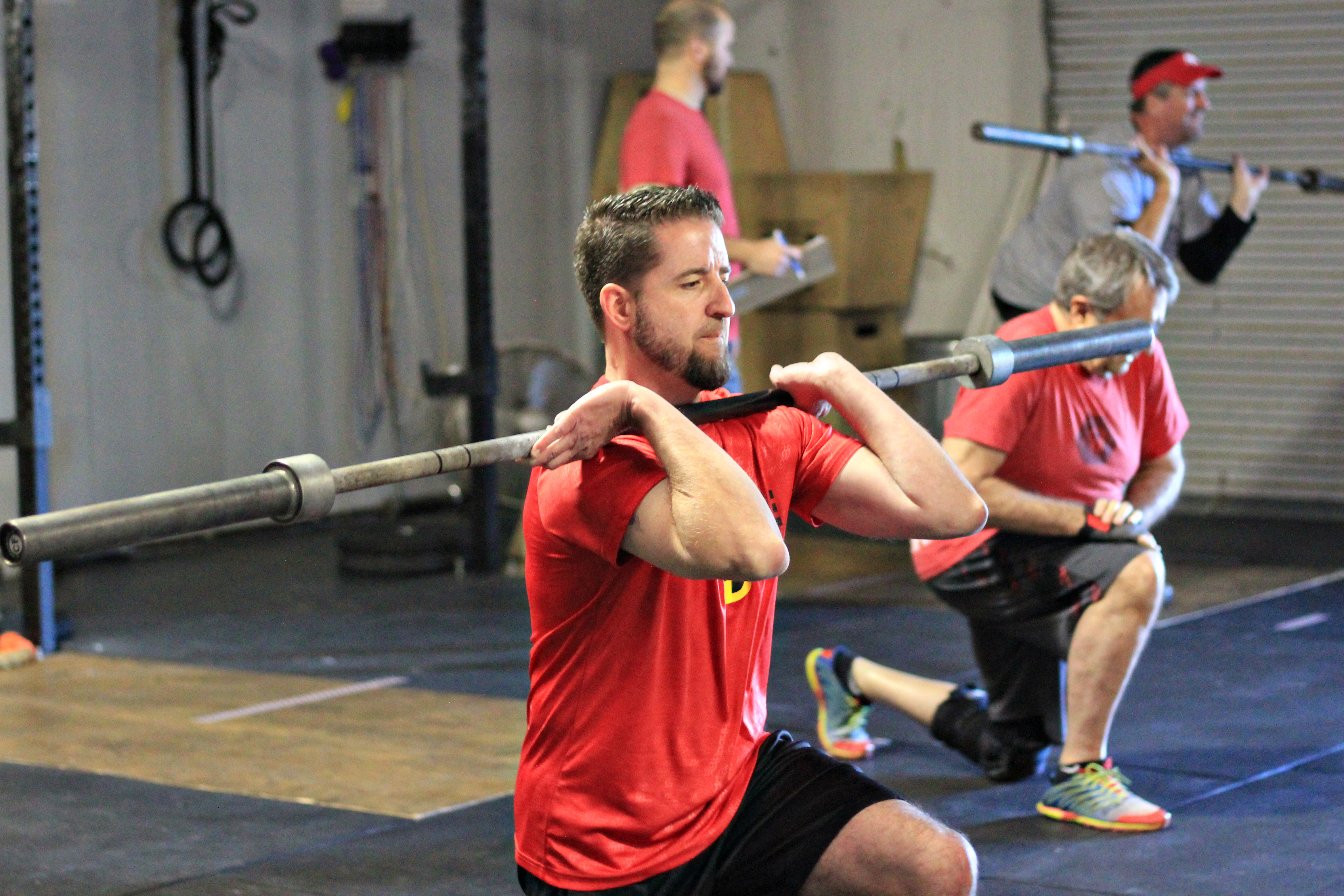
- GHD Sit Ups – Short for glute/ham developer, most CrossFit gyms have GHD machines, which you’ll use for GHD sit ups, hip extensions and back extensions. For a video demonstration of a GHD sit up, click here.
- Goblet Squat – completing an air squat while holding a kettlebell or dumbell at the center of your chest
- Hip extension – For a video demonstration of a hip extension using a GHD machine, click here.
- Jumping Pull Ups – A pull up modification. You start below the bar with your arms at full extension and then jump while simultaneously pulling yourself above the bar. For a video demonstration of a jumping pull up, click here.
- Kettle bell – A kettle bell is actually a piece of equipment, but when CrossFitters refer to kettle bells in a WOD, they are referring to a movement where you begin with your feet hip-width apart. You grasp the kettle bell by its handle with both hands and hang it between your legs. Then, you thrust your hips forward and use the momentum to swing the kettle bell over your head. For a video demonstration of a kettle bell, click here. Sometimes also referred to as an American Kettle Bell Swing.
- Kipping – Kipping refers to a swinging motions used during pull ups. For a video demonstration of a kipping pull up, click here. Kipping can also refer to bringing your legs down and pushing them back up to gain momentum during a hand stand push up. For a video demonstration of a kipping hand stand push up, click here.
- Lunges – To complete a lung, you start in the standing position. Move one leg forward while keeping one foot in place. The leg that stays in place will then bend, allowing the knee to touch the ground before coming back up in a standing position. For a video demonstration of a lunge, click here.
- Overhead Weighted Lunges – Lunging while holding something weighted, usually a bumper, overhead.
- Prison Squat – completing an air squat while holding each hand behind your head.
-
Prowler – For a video demonstration of a forward sled push, click here. Sometimes also referred to as a forward sled push.
- Pull Up – To complete a pull up, you start underneath the rig with hands a little further than shoulder width apart on the bar. You then engage your shoulders, core, lats and delts and pull yourself over the bar. For a video demonstration of a pull up, click here.
- Push Up – You start out flat on the ground with each shoulder a little outside of each shoulder with your palms flat against the ground. You then engage your core and glutes and push your body up off the ground while staying tight and parallel before lowering yourself back down. For a video demonstration of a push up, click here.
- Rope Pull – This is a movement made famous by the Strongman competition. During it, an athlete is fully seated on the ground, usually with their legs extended in front of them pulling weights or a heavy object towards them by a rope with their arms.
- Rowing – This is a movement performed on a rower. You will be in a seated position with your feet strapped in and will be pulling a handle towards your chest. For a video demonstration of rowing, click here.
- Russian Kettle Bell Swings – A Russian kettle bell is a movement where you begin with your feet hip-width apart. You grasp the kettle bell by its handle with both hands and hang it between your legs. Then, you thrust your hips forward and use the momentum to swing the kettle bell to eye level before dropping it between your legs again. Your spine should stay neutral and your force should come from your hips and quads.
- Russian Twists – A Russian twist starts out with you sitting on the ground. You will bend at the hips and leave your feet a few inches off the floor. Holding a small med ball in your hands, you will alternate side to side, touching the ball to the ground beside each hip while keeping your core muscles engaged.
- Sit Up – You will start lying down with your legs extended out. You can cross your hands over your chest or hold them straight overhead while bending at the waist and sitting up without removing your legs from the floor.
- Sled Pull – Using a shoulder harness to pull a weighted object behind you while running or walking. For a video demonstration of a sled pull, click here.
- Tire Flip – Letting your inner beast out by flipping over heavy tires. Remember to keep a neutral spine and lift with your legs and butt, not your back.
- Turkish Get Ups – For a video demonstration on how to do a turkish get up, click here.
- Waiter’s Carry – Carrying a heavy weight in one hand (or one in each hand), usually a kettle bell, over your head for a predetermined distance.
- Wall Balls – To perform a wall ball, you will start below your target with your feet shoulder-width apart. You will take a large med ball and hold it between your hands in front of your face. Without dropping your shoulders or chest, you will perform a full squat and then go immediately back into the standing position while throwing the ball at the target. For a video demonstration of wall balls, click here.
-
Weighted Lunges – Yes, it’s just as terrible as it sounds. Doing lunges while holding a heavy weight.
Gymnastics Movements
- Hand Stand – Getting vertical on your hands
-
Hand Stand Push Up – Assuming the hand stand position, bending your arms while keeping your body upwards and tight and then pushing yourself back up to your original position. You can do these “strict” by not bending your legs or use your legs to “kip” or gain momentum, as pictured below.
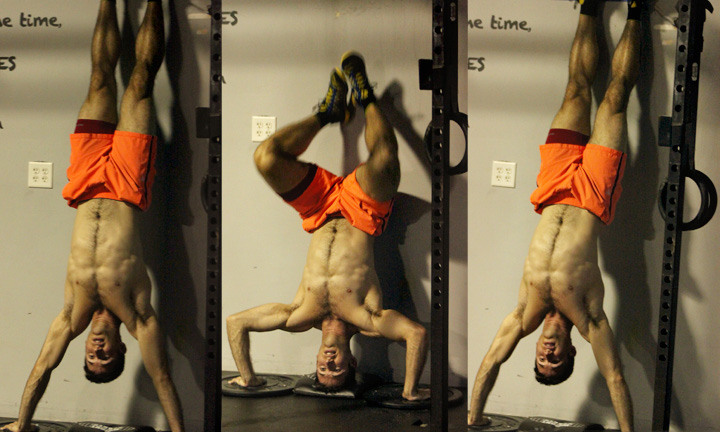
- Muscle Up – For a video demonstration of a muscle up, click here.
- Pistol – You will start in the standing position and then slowly (or quickly if you’re good at them) drop down on one foot while keeping the other leg straight and extended in front of you, and then stand back up. For a video demonstration of a pistol, click here.
- Ring Dips – Performed by holding yourself up on gymnastic rings and then dipping, or bringing your shoulders to your hands. For a video demonstration of ring dips, click here.
-
Ring Rows – Position yourself below the rings and pull the rings to your chest while keeping your core and glute muscles tight. For a video demonstration on ring rows, click here.
- Rope Climb – Climbing a rope. Think of high school gym days.
-
Toes to Bar – You will start out with your hands a little further than shoulder-width apart on the bar. Then, you will lift your toes to touch the bar using your core muscles. You may also kip this movement.
- Toes to Ring – You will start out by grabbing onto the rings above your head using a hook grip. Then, you will lift your toes to touch the rings using your core muscles. You may also kip this movement.
CrossFit Acronyms
- AKBS – American kettlebell swings
- C2B – Chest to Bar
- GTOH – Ground to overhead
- HSPU – Hand stand push up
- KBS – Kettlebell swings
- T2B – Toes to bar
- T2R – Toes to ring
- RKBS – Russian kettlebell swings
- STOH – Shoulder to overhead; moving the bar from the front rack position to the overhead position. Generally, you can move it using a strict press, a push press or a jerk unless the workout otherwise specifies.
Other CrossFit Terminology
- Front Rack Position – The position picture below. The bar should be resting on or around your collarbones. You can hold it in place with your hands or actually cross your arms over your chest.
- Hook Grip – Wrapping your hand around the bar and around your thumb. This is the safest way to grip a bar or a rig.
- Parallel – People usually use this term in reference to squats — you need to get below parallel or you aren’t dipping below parallel. To get below parallel, your butt must dip below your hip hinge in a squat. When your butt is at the same level as the hip hinge, it is parallel to the hip hinge, hence the terminology.
- Receiving Position – When Olympic lifting, you can receive your bar in the power position or in the squat position. The power position is referring to catching the bar in that front rack position while either standing straight up or standing almost all the way up as you would in a power clean or a hang clean. The squat position is catching the bar below parallel, as you would in a squat snatch or a squat clean.
Muscle Groups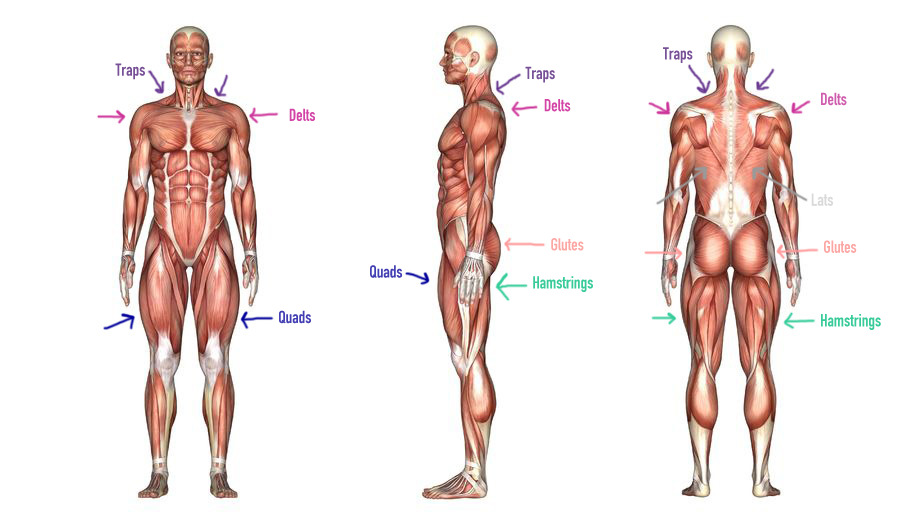
- Delts – Short for deltoid muscles, your delts are found in your upper arms. These muscles are used commonly in CrossFit movements such as presses and hand stands or hand stand pushups.
- Glutes – Short for gluteus maximus, gluteus medias and gluteus minimus, your glutes are essentially the muscles that form your booty. You use these muscles commonly in CrossFit for…pretty much everything, but most notoriously, squats and dead lifts.
- Hamstrings – Affectionately known as hammies, your hamstrings are found on the reverse side of your thigh from your quads. They occupy the space from the bottom of your booty all the way down to your knees. You should also feel these muscles during squats as well as many other exercises like running, box jumps and dead lifting.
- Lats – Short for latissimus dorsi and are found in your upper back. Your lat muscles are used commonly in CrossFit movements like pull ups and overhead movements.
- Traps – Short for trapezius muscles, your traps are found between your neck and shoulder. Any movement that engages a shrug — think a snatch or a clean — is going to work your trap muscles.
- Quads – Short for quadriceps femoris muscles, your quads are located in the front of your thighs. You probably know all about your quad muscles from squat movements.
Verbal Cues
- Activate Your Shoulders – Engage your shoulder muscles. Act like you’re trying to show off your armpits when you have the bar overhead.
- Below Parallel – Your booty should be dipping below your hip hinge.
- Chest Up – Keep your shoulders back and your chest up while lifting.
- Don’t Go To the Pain Cave – When stretching, don’t stretch your muscles to the point to where it restricts circulation, causes pain and causes you to lose consciousness.
- Engage Your Core – Tighten your ab and glute muscles.
- Flat Back – Resist the urge to curve your back when performing lifts such as the deadlift. Your back should be flat and straight throughout the lift.
- Get Under the Bar – Use your legs to propel yourself under the bar when you putting it overhead in movements like a snatch or a jerk.
- Open Up Your Hips – Point your knees outward and keep your spine neutral.
- Pull the Bar Apart – When your hands are in a snatch position, “Pull the Bar Apart” means you should be pushing towards the outer edges of your hands as if you were literally trying to rip the barbell apart.
- Screw Your Feet Into the Floor – This cue is usually given during squat-type movements and it refers to pushing through the outer edges of your feet for maximum stability as if you are literally trying to screw your feet into the floor.
- Spread the Floor With Your Feet – This is another squat cue that also refers to pushing through the outer edges of your feet. You should treat the floor as if you are straddling a crack that you are trying to pull apart solely using your feet.
CrossFit Competitions
- The CrossFit Open – a competition beginning in February each year where CrossFitters compete in their home gyms and submit their scores via video to be validated by judges. The Open is the first round of elimination for the CrossFit Games.
- Regionals – Top athletes from the 17 worldwide regions in the Open then move on to eight different Regional competitions where they will continue to compete for a spot in the CrossFit Games.
- The CrossFit Games – The final round of competition where the top 40 men and women from around the world will compete for a shot at becoming The Fittest Man and Fittest Woman on Earth.
- CrossFit Invitational – Teams that compete in the CrossFit games are bound by rules — they must workout at the same gym and things of that nature. The CrossFit Invitational Series is more of a Fantasy-type competition where the best of the best from each country form teams and go against teams in other countries.
- CrossFit Team Series – Teams that compete in the CrossFit games are bound by rules — they must workout at the same gym and things of that nature. The CrossFit Team Series is more of a Fantasy-type competition where athletes from all over the world pair up into teams and compete against one another. This competition is similar to the Invitational except that anyone can sign up to compete and athletes aren’t regulated by what country they live in.
- CrossFit Lift Off Series – A series similar to the Open in that it can be done in home gyms and is judged via videos. Beginning in November, athletes compete in three weightlifting events to see where they stand against other CrossFitters around the world in regards to the weight they can lift.
